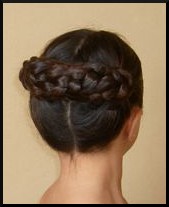Dancers stand in front of the examiner in the following way:
Examiner
4 3 2 1
RAD Intermediate
Foundation
These are
videos available on the Internet. I have watched them all to make sure they are
correct. I discovered someone has already done a video glossary, which is most
useful of the steps you need for the free work. Shown in isolation, you can
practice them and perhaps link some.
BARRE :
All the
barre work in order – https://www.youtube.com/watch?v=3d0-rD-p79o
CENTRE
WORK
Ports de
bras – https://www.youtube.com/watch?v=3RjyZGXqTm8
NOTE – these
dancers do a slight spring to the side on the “forward, side, back” (open pas
de bourrée over – Dessus) In the book, it details ONLY Pose, which means ‘step’.
There is no spring, but you should make it flow.
Centre Practice and Pirouettes – https://www.youtube.com/watch?v=nMWGupdmx8Y
This is a really nicely controlled example.
Pirouettes en dedans – https://www.youtube.com/watch?v=yCTEOIY2ESs
This class show a solid example of the exercise.
Adage – https://www.youtube.com/watch?v=Ufdq0DUJkNw
Absolutely correct to the syllabus book.
Allegro 1 – https://www.youtube.com/watch?v=J1CeuWrbVIE
This adult dancer has lovely feet, this is what you are
working towards – feet and bounce.
Allegro 2 – https://www.youtube.com/watch?v=yErFrQr4VjY
Allegro 3 – https://www.youtube.com/watch?v=Ssq-oZ1pnmU
Free work – focal steps and linking steps – https://www.youtube.com/watch?v=L8W1IhZiIJU
Variation 1 – https://www.youtube.com/watch?v=xvI7nIVn9r0
From the RAD DVD.
POINTE WORK – here are some basic exercises to start practicing at home:
Rises – 3 rises, tendu to second, transfer of weight through
demi plie to the other foot and close. Repeat.
Echappes releves and courus – releve 5th, echappe
releve to second changing feet 2x, releve in 5th, stay up and hold,
couru to change feet, straighten knees on 5, lower 6,7,8. Repeat starting with
the other foot.
Echappes releves and classical walks – repeat the releve
section above, plu 3 classical walks, starting with the back foot, close on 8.
Repeat.
Exam Day – what to expect – https://www.youtube.com/watch?v=LLouywuk5js&t=7s


